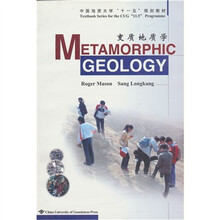中国地质大学“十一五”规划教材:变质地质学

目 录内容简介
Chapter 1 Definition of metamorphism, classification of metamorphic rocks
1.1 Definition of metamorphism
1.2 Classification and nomenclature of metamorphic rocks
1.3 The minerals of metamorphic rocks
1.4 English mineral names
1.5 Description of thin sections of metamorphic rocks
HOMEWORK
Chapter 2 Conditions of metamorphism, P-T-t paths, the Phase Rule, composition-assemblage diagrams, metamorphic facies
2.1 Limits of metamorphism
2.2 P-T-t paths
2.3 Equilibrium
2.4 The Phase Rule
2.5 Using the Phase Rule to fix P- T Conditions
2.6 AFM diagrams
2.7 Metamorphic facies
HOMEWORK
Chapter 3 Contact metamorphism 1 : the role of heat
3.1 Introduction
3.2 Contact aureole of the Markfield Diorite, Leicestershire, England
3.3 Contact aureole of the Skiddaw Granite, Lake District, England
3.4 Heat transfer at the contacts of intrusions
3.5 Effect of intrusion size and shape on aureole size and shape
3.6 Thermal conduction models of contact aureoles
3.7 Thermal convection models of contact aureoles
3.8 Facies series in contact metamorphism
HOMEWORK
Chapter 4 Contact metamorphism 2: the role of fluids
4.1 Introduction
4.2 Contact metamorphism of limestone
4.3 Buffering of H2O and CO2 in calcareous skarns
4.4 Very high temperature reactions between calcite and quartz
4.5 Discussion
HOMEWORK
Chapter 5 Dynamic metamorphism
5.1 Introduction and definition
5.2 Strain
5.3 Classification of dynamic metamorphic rocks
5.4 The Lochseiten Mylonite, Switzerland
5.5 Dynamic metamorphism in Dengfeng County, Henan Province
5.6 Dynamic metamorphism in relation to depth
5.7 Microstructures of metamorphic rocks
HOMEWORK
Chapter 6 Regional metamorphism 1: Barrows Metamorphic Zones
6.1 Introduction
6.2 Barrows Zones in pelitic rocks
6.3 Changes in mineral assemblages with metamorphic grade
6.4 The Sulitjelma District, Norway and Sweden
6.5 Garnet growth and zoning at Sulitjelma
6.6 Geothermal gradients and metamorphic field gradients
HOMEWORK
Chapter 7 Regional metamorphism 2: basic igneous rocks
7.1 Sulitjelma greenstones and amphibolites
7.2 The boundary between the greenschist and amphibolite facies
7.3 ACF triangular diagrams to represent mineral assemblages of metabasites
7.4 Plotting ACF triangular diagrams
7.5 Metamorphic temperature gradients in sedimentary basins
HOMEWORK
Chapter 8 Regional metamorphism 3: ocean floor metamorphism
8.1 Metamorphism at spreading ocean ridges
8.2 The Troodos Ophiolite, Cyprus
8.3 Petrology of the Ophiolite
8.4 Structure and geothermal gradients of oceanic ridges
8.5 Hydrothermal activity near spreading ridges
8.6 Conclusions
HOMEWORK
Chapter 9 Regional metamorphism 4: high temperature metamorphism
9.1 Partial melting and migmatites
9.2 Structural varieties of migmatite
9.3 Field relations of migmatites
9.4 The granulite facies
9.5 Why are granulites so dry?
9.6 The Adirondack Mountains, New York State, USA
9.7 Ultra-high temperature metamorphism
HOMEWORK
Chapter 10 Regional metamorphism 5: HP and UHP metamorphism
10.1 High pressure metamorphism
10.2 The Franciscan metamorphic belt of California
10.3 Eclogites and the eclogite facies
10.4 Ultra high pressure metamorphism
10.5 How did HP and UHP rocks get back to the surface?
10.6 UHP rocks, the range of conditions of metamorphism and implications for metamorphic facies
HOMEWORK
Chapter 11 Extra-terrestrial metamorphism
11.1 Impact metamorphism
11.2 Meteor Crater, Arizona, USA
11.3 Shock metamorphism at the N6rdlinger Ries Crater, Germany
1.1 Definition of metamorphism
1.2 Classification and nomenclature of metamorphic rocks
1.3 The minerals of metamorphic rocks
1.4 English mineral names
1.5 Description of thin sections of metamorphic rocks
HOMEWORK
Chapter 2 Conditions of metamorphism, P-T-t paths, the Phase Rule, composition-assemblage diagrams, metamorphic facies
2.1 Limits of metamorphism
2.2 P-T-t paths
2.3 Equilibrium
2.4 The Phase Rule
2.5 Using the Phase Rule to fix P- T Conditions
2.6 AFM diagrams
2.7 Metamorphic facies
HOMEWORK
Chapter 3 Contact metamorphism 1 : the role of heat
3.1 Introduction
3.2 Contact aureole of the Markfield Diorite, Leicestershire, England
3.3 Contact aureole of the Skiddaw Granite, Lake District, England
3.4 Heat transfer at the contacts of intrusions
3.5 Effect of intrusion size and shape on aureole size and shape
3.6 Thermal conduction models of contact aureoles
3.7 Thermal convection models of contact aureoles
3.8 Facies series in contact metamorphism
HOMEWORK
Chapter 4 Contact metamorphism 2: the role of fluids
4.1 Introduction
4.2 Contact metamorphism of limestone
4.3 Buffering of H2O and CO2 in calcareous skarns
4.4 Very high temperature reactions between calcite and quartz
4.5 Discussion
HOMEWORK
Chapter 5 Dynamic metamorphism
5.1 Introduction and definition
5.2 Strain
5.3 Classification of dynamic metamorphic rocks
5.4 The Lochseiten Mylonite, Switzerland
5.5 Dynamic metamorphism in Dengfeng County, Henan Province
5.6 Dynamic metamorphism in relation to depth
5.7 Microstructures of metamorphic rocks
HOMEWORK
Chapter 6 Regional metamorphism 1: Barrows Metamorphic Zones
6.1 Introduction
6.2 Barrows Zones in pelitic rocks
6.3 Changes in mineral assemblages with metamorphic grade
6.4 The Sulitjelma District, Norway and Sweden
6.5 Garnet growth and zoning at Sulitjelma
6.6 Geothermal gradients and metamorphic field gradients
HOMEWORK
Chapter 7 Regional metamorphism 2: basic igneous rocks
7.1 Sulitjelma greenstones and amphibolites
7.2 The boundary between the greenschist and amphibolite facies
7.3 ACF triangular diagrams to represent mineral assemblages of metabasites
7.4 Plotting ACF triangular diagrams
7.5 Metamorphic temperature gradients in sedimentary basins
HOMEWORK
Chapter 8 Regional metamorphism 3: ocean floor metamorphism
8.1 Metamorphism at spreading ocean ridges
8.2 The Troodos Ophiolite, Cyprus
8.3 Petrology of the Ophiolite
8.4 Structure and geothermal gradients of oceanic ridges
8.5 Hydrothermal activity near spreading ridges
8.6 Conclusions
HOMEWORK
Chapter 9 Regional metamorphism 4: high temperature metamorphism
9.1 Partial melting and migmatites
9.2 Structural varieties of migmatite
9.3 Field relations of migmatites
9.4 The granulite facies
9.5 Why are granulites so dry?
9.6 The Adirondack Mountains, New York State, USA
9.7 Ultra-high temperature metamorphism
HOMEWORK
Chapter 10 Regional metamorphism 5: HP and UHP metamorphism
10.1 High pressure metamorphism
10.2 The Franciscan metamorphic belt of California
10.3 Eclogites and the eclogite facies
10.4 Ultra high pressure metamorphism
10.5 How did HP and UHP rocks get back to the surface?
10.6 UHP rocks, the range of conditions of metamorphism and implications for metamorphic facies
HOMEWORK
Chapter 11 Extra-terrestrial metamorphism
11.1 Impact metamorphism
11.2 Meteor Crater, Arizona, USA
11.3 Shock metamorphism at the N6rdlinger Ries Crater, Germany
目 录内容简介
《中国地质大学“十一五”规划教材:变质地质学》是随着20世纪60年代板块构造学兴起而迅速发展起来的地质学科,作为课程,它属于地质专业课程性质,具有显著的地质前沿和岩石学与构造学学科交叉特点。《中国地质大学“十一五”规划教材:变质地质学》全面介绍了变质岩石学和变质地质学的基础理论、基础知识和基本技能。内容主要包括变质作用通论、接触变质、动力变质和区域变质及地外变质五大部分。
比价列表
公众号、微信群
 缺书网
缺书网微信公众号
 扫码进群
扫码进群实时获取购书优惠






